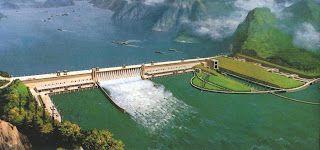Capacity -
The Three Gorges Dam is the world’s largest capacity hydroelectric power station with a total generating capacity of 18,200MW. It has twenty-six 700MW turbines and eventually it will have 32 generators making a total capacity of 22,500MW. The first generator started on July 10, 2003. The 14 north side generators and 12 south side generators are in operation. Six underground generators are expected to be completed by 2012.
Distribution -
The power from The Three Gorges Dam is distributed to various cities and provinces in Central, South and East China at the price around $36/MWh. Nine provinces and two cities including Shanghai consume power from the dam.
Power distribution and transmission infrastructure cost about $5 billion. Power is distributed over multiple 500kV lines. 3 DC lines to the East China carry 7,200MW. 1 DC lines to the South China has capacity of 3,000MW. The DC lines have advantages of power transportation over long distance in the geography.
Environmental and economical -
The Three Gorges reduces coal consumption by 31 million tonnes per year, avoiding 100 million tonnes of greenhouse gas emissions, 370,000 tons of nitric oxide, 10,000 tons of carbon monoxide, and a significant amount of mercury, reducing carbon dioxide by 190 million tons, sulfur dioxide by 2.29 million tons and nitrogen oxides by 980,000 tons from 2003 to 2007 alone.
The Three Gorges Dam project costs $22.5 billion.

